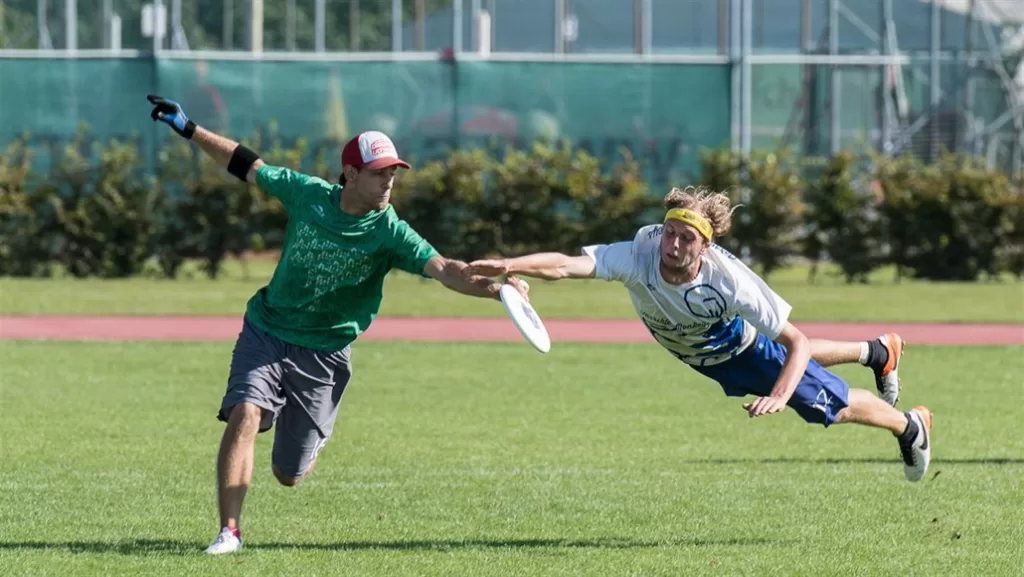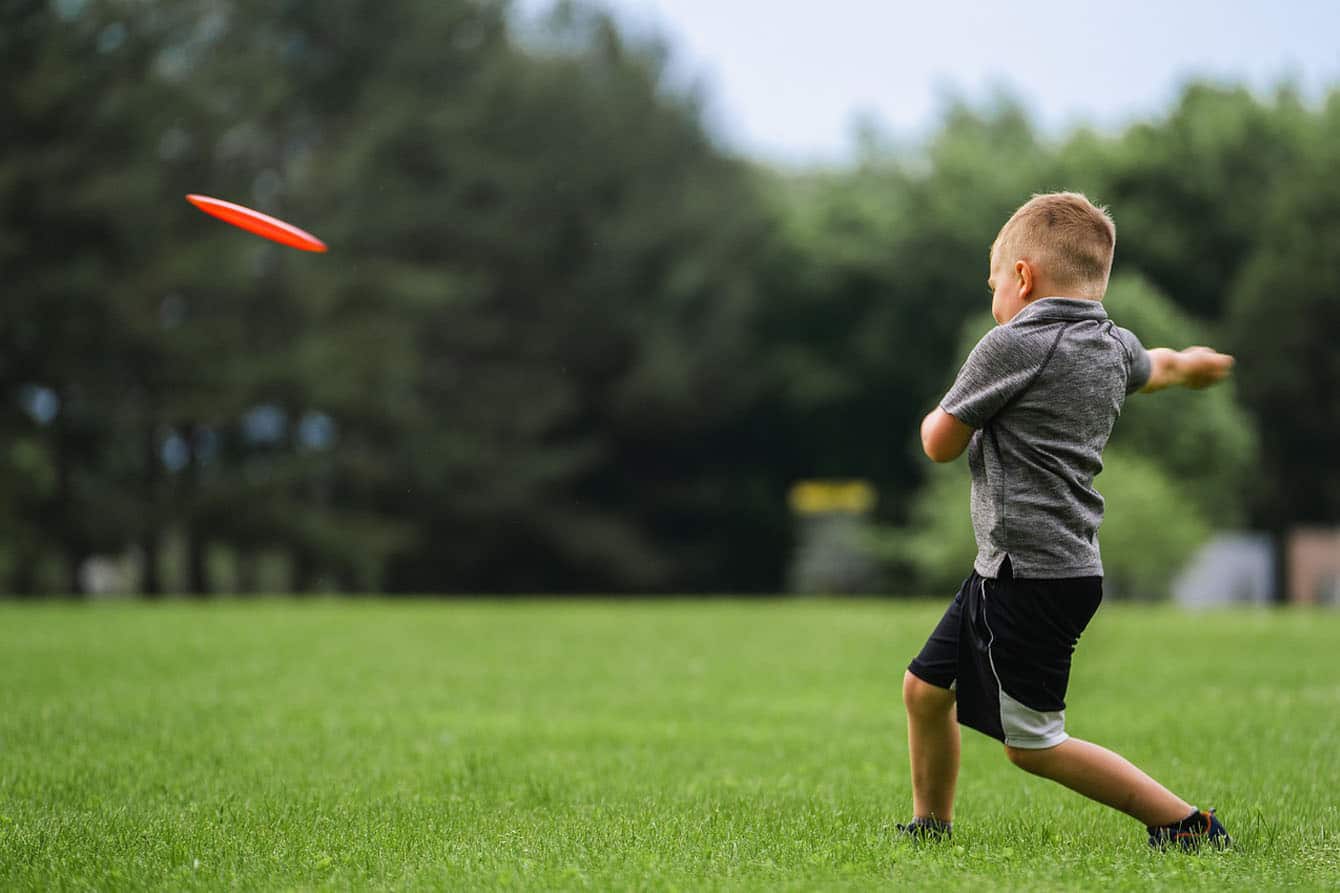The flying principle of Frisbee is based on aerodynamics and inertia. By constantly adjusting the angle of throwing, speed, and rotation, the Frisbee can be kept in a stable flying condition in the air. At the same time, different control methods, such as hand tossing, wind control, electric control, etc., can also affect the flight trajectory and stability of the Frisbee. In this article, we will discuss the flying principle of Frisbee and its different control methods and their application scenarios.

The Main Components and Principles of Frisbee
Components of the Frisbee
The main components of a frisbee include shape, material, weight, and surface texture. Modern discs are generally made of materials such as plastic, rubber, or polyurethane, and they are usually flat, round, or round-like, with raised edges and a concave center. Frisbees vary in size, shape, and weight to suit different usage needs. The surface of the disc usually has a bumpy texture, which helps improve grip and control of the disc.
Principles of Frisbee
When the disc is thrown, it is subjected to air resistance that causes it to start spinning. The rotation of the disc and the flow of air interact to create lift and drag, which allows the disc to fly and maintain a stable attitude. The distance between the center of gravity and the aerodynamic center of the disc also affects the flying characteristics of the disc.
When the disc is thrown, its axis of rotation will continue to maintain rotation in the air. This rotational stability and inertia maintain the disc’s attitude and flight path in the air.
In short, the Frisbee is a motion toy based on aerodynamics and inertia. Its shape, material, weight, and surface texture are all characteristics that have an impact on its flight characteristics. For disc sports enthusiasts, understanding the composition and principles of the disc can help them better master the flying and control skills of the disc.
The Physical Mechanics of Flight
First of all, gravity refers to the gravitational force of the earth on the disc. After the disc is thrown will be subject to the action of gravity and fall, The role of gravity is to make the disc downward acceleration, but also to control the height of the disc and the landing point is an important factor.
Secondly, air resistance refers to the obstruction of the disc by the air. When the disc is moving in the air, the air will exert resistance on the disc, which will slow down the speed of the disc and make it gradually reduce its height. At the same time, the shape and surface texture of the disc will also affect the size and direction of the air resistance, thus affecting the flying characteristics of the disc.
Finally, buoyancy is the upward force on the disc in the air. As the disc flies through the air, it interacts with the air, creating an airflow, and the airflow creates an upward buoyancy force on the lower surface of the disc. This buoyancy helps the disc maintain a stable flying attitude and allows it to glide further in the air.
In short, gravity, air resistance, and buoyancy are the main mechanical effects that affect the flight of a disc. For disc sports enthusiasts, understanding these mechanics can help them master the flying skills of discs and improve their flight distance and stability.
In-Flight Parameters and Measurement Methods
Parameters such as speed, rotation angle, and altitude of the disc in flight are crucial for disc players because they directly affect the trajectory and distance of the disc. The following are some common measurements:
- Speed: The speed of a Frisbee can be calculated by measuring its distance and time of flight. Some advanced athletes will use a radar tachymeter to measure the disc speed to control the flight more precisely.
- Rotation angle: The rotation angle of the disc is very important to control the direction and distance of the flight. During the flight, you can judge the rotation angle by observing the direction and speed of the disc’s rotation.
- Height: Measuring the height of the disc can help the athlete control the rise and fall of the disc so as to achieve a longer flight distance. Tools such as a laser altimeter or rangefinder can be used to measure the height of the disc.
In addition, there are other parameters that can affect the flight trajectory and distance of the disc, such as the weight, shape, and surface texture of the disc. Therefore, the design and manufacturing process of the discs need to be constantly adjusted and improved to achieve better flight performance.
Analysis and Optimization of Flight Stability
The stability of the disc is a key factor affecting the distance and direction of its flight. During the flight, the disc needs to maintain a stable flight attitude to avoid flying off the expected trajectory or flipping over and falling to the ground. The following are some of the factors that affect the stability of the disc:
- The center of gravity and weight distribution of the disc: The center of gravity and weight distribution of the disc have an important impact on its stability. If the center of gravity is too far from the center, the disc will easily flip or fly unstably. Therefore, the center of gravity of the disc should be as close to its geometric center as possible, and the weight distribution should be even.
- Disc shape and surface texture: The shape and surface texture of the disc will also affect its stability. Some professional discs are designed with more complex geometry and surface texture to improve the stability and aerodynamic performance of the disc.
- Flight speed and rotation angle: The flight speed and rotation angle of the disc will also affect its stability. In general, discs make it easier to maintain a stable flight attitude at higher speeds and smaller rotation angles.
In addition, wind resistance performance is also an important factor affecting the stability of the disc. Discs need to have sufficient wind resistance when flying in strong winds to avoid the flight being affected by the wind and deviating from the trajectory. In order to improve the wind resistance of the disc, you can use a better aerodynamic performance design, or increase the weight of the disc to increase its inertia.
In conclusion, the stability and wind resistance of the disc an important factors to be considered in the design and manufacture of the disc, and only by ensuring these factors can the disc achieve a more stable and longer flight distance.

Frisbee Manufacturing Process and Material Selection
Various Processes
The manufacturing process and material selection of a disc have a direct impact on its performance. The following are a few common manufacturing processes and material choices and how they affect the performance of the disc:
- Compression Molding: Compression molding is a common disc manufacturing process. The process produces flat, smooth, consistent discs that can be produced quickly and on a large scale. However, the discs manufactured by this process may be hard, not easily bent, and not flexible enough.
- Vacuum Blister: Vacuum Blister is a method of forming molded parts by attaching thermoplastic to the surface of a mold by vacuum suction. This process can produce discs with different shapes and structures and allows for precise control of material thickness and strength. However, the process also has problems such as high manufacturing costs and complicated processes.
- Handmade: Handmade is a traditional manufacturing method. This method can achieve personalized and artistic disc design and can be made with a variety of materials. However, the quality and performance of hand-made products may vary, and the production efficiency is relatively low.
Materials Selection
In terms of material selection, commonly used materials include polyurethane, plastic, rubber, silicone, wood, etc. Different materials can affect the performance of the disc such as elasticity, durability, weight, and resistance. For example, plastic materials are usually lighter in weight and can achieve longer flight distances, but may also lack some of the necessary flexibility and resistance; rubber materials provide better grip and resistance, but also increase the weight of the disc.
In summary, the manufacturing process and material selection of the disc should be based on the design goals and usage scenarios. Different manufacturing processes and material choices may affect the performance and cost of the disc, so all aspects need to be considered to achieve the best manufacturing results.
Comparison of Different Control Methods and Application Scenarios
The control of the disc can be divided into three types: hand throw, wind control, and electric control.
- Hand toss control: Hand toss control is the most common way to control the disc. The user controls the direction and height of the disc by throwing it by hand. The control method is simple and easy to learn, suitable for a variety of indoor and outdoor scenes.
- Wind control: Wind control is to control the direction and height of the disc by controlling the wind speed and direction. For example, in kitesurfing, athletes can control the direction and height of the disc by adjusting the angle of the kite and the line. This control method needs strong wind and wind direction, which is suitable for outdoor and windy environments.
- Electric control: Electric control is to control the direction and height of the disc through electronic devices such as a motor and remote control. This control method is suitable for scenarios that require higher precision, high-speed flight, and complex paths, such as athletic competitions and scientific research.
Different control methods are suitable for different scenes and needs. The hand-throw control method is simple and easy to learn, suitable for various scenes; the wind control method needs proper environment and wind power, suitable for outdoor activities; the electric control method can achieve high precision and high-speed flight, suitable for competitive competitions and scientific research. Therefore, when choosing the Frisbee control method, we need to consider the use of scenes, needs, control accuracy, and other factors to choose the most suitable control method.
Disc Movement Trajectory and Control Methods
Frisbee in flight can present a variety of trajectories, the most common are parabolic, straight line, spiral, and so on.
- Parabolic motion: When the disc is thrown, under the action of gravity, its trajectory shows a parabolic shape. This trajectory is characterized by the initial speed and launch angle to determine the farthest distance and landing position of the disc, The control method is to change the throwing angle and initial speed to control the landing position of the disc.
- Linear motion: When the disc is thrown in a horizontal direction, and in the course of flight by the airflow and external forces are small, the disc’s trajectory is a straight line shape. This trajectory is characterized by stable speed and direction, the control method is to control the trajectory of the disc by adjusting the throwing force and direction.
- Spiral movement: In throwing, if you give the disc a rotating power, the disc will show a spiral trajectory in flight. This kind of trajectory is characterized by rotation speed and rotation direction to determine the trajectory and landing position of the disc, The control method is to control the trajectory of the disc by changing the rotation speed and rotation direction.
Controlling the trajectory of the disc requires different control methods according to the characteristics of different trajectories. For example, the parabolic trajectory of the disc can be controlled by changing the throwing angle and initial speed; the straight trajectory of the disc can be controlled by adjusting the throwing force and direction; control of the spiral trajectory of the disc can be controlled by changing the rotation speed and rotation direction. In control of the trajectory of the disc, one also needs to consider the wind direction, air resistance, and other external factors on the trajectory of the disc, comprehensive consideration of these factors to control.
Possible In-Flight Problems and Solutions
Frisbee, as a flying toy, may encounter some problems in the process of use. The following are some common problems and the corresponding solutions:
- Disc instability: If the disc is unstable in flight, it may be because the hand toss is not at the correct strength or angle, or the disc’s center of gravity is not properly positioned. The solution is to make sure that the hand tossing strength and angle are appropriate and try to adjust the disc’s center of gravity position.
- Insufficient flight distance: If the flying distance of the disc is not enough, it may be because the weight of the disc is too heavy or the material is not suitable. The solution is to choose a lighter disc or use a more suitable material, such as polyurethane, polyethylene, or polycarbonate.
- Discs stick to your hands: If the disc sticks to your hands, it may be because there is sweat on your hands or because the material of the disc is too sticky. The solution is to apply some powder on your hands, such as cornstarch, or choose a disc with a smoother material.
- Discs are easy to flip: If the disc is easy to flip during the flight, it may be because the edge of the disc is too sharp, or the center of gravity is not appropriate. The solution is to choose a disc with smoother edges and try to adjust the disc’s center of gravity.
- The disc is affected by the wind: If the disc is affected by the wind during the flight, it may cause the flight path to shift or flight height instability. The solution is to choose a disc with better wind resistance or adjust the angle and strength of the flight according to the wind direction and wind conditions.
In short, to solve the problems of the flying disc need to take appropriate measures according to the specific situation. By choosing the appropriate disc, adjusting the position of the center of gravity, and controlling the flight angle, the stability of the disc and the flight effect can be improved.

Conclusion
Understanding the aerodynamics and control mechanisms behind the flight of a flying disc offers insights into its captivating motion. As enthusiasts and manufacturers alike continue to innovate, the future of flying discs promises even more exciting developments and applications.

